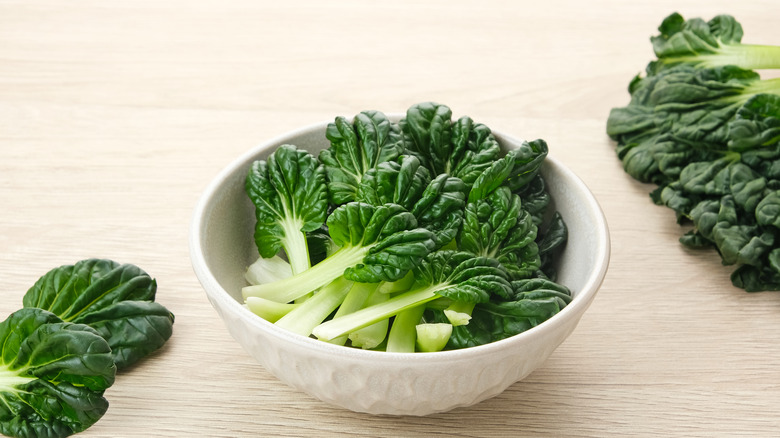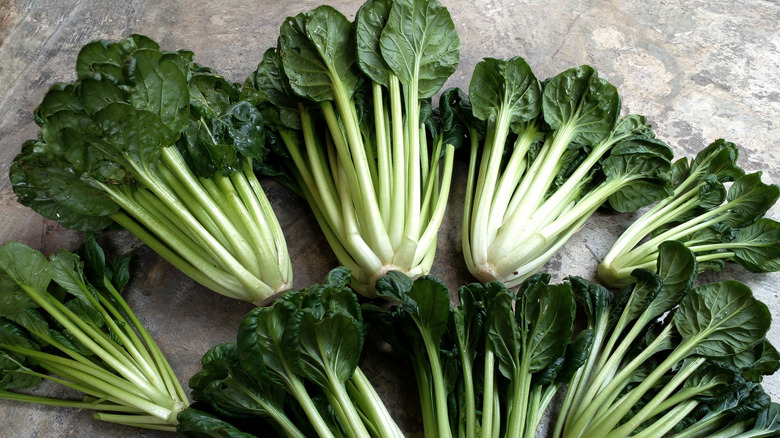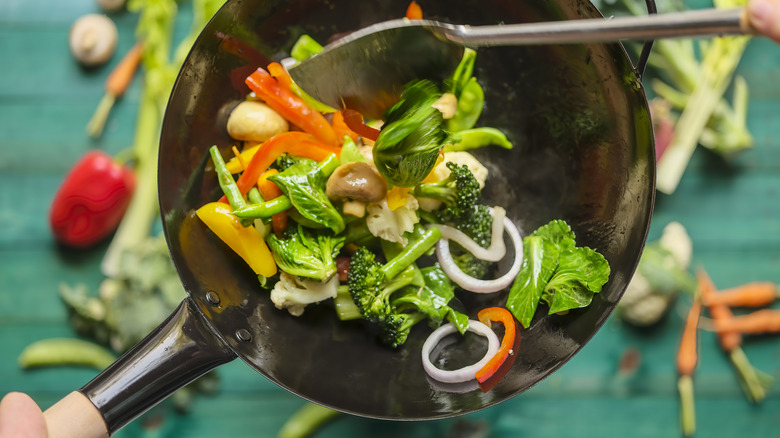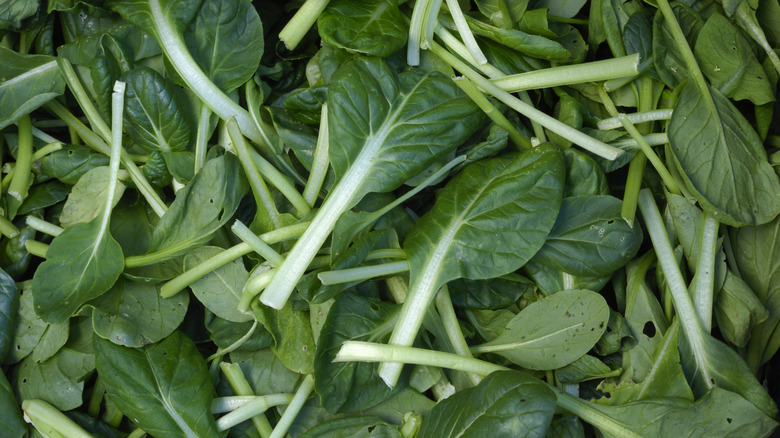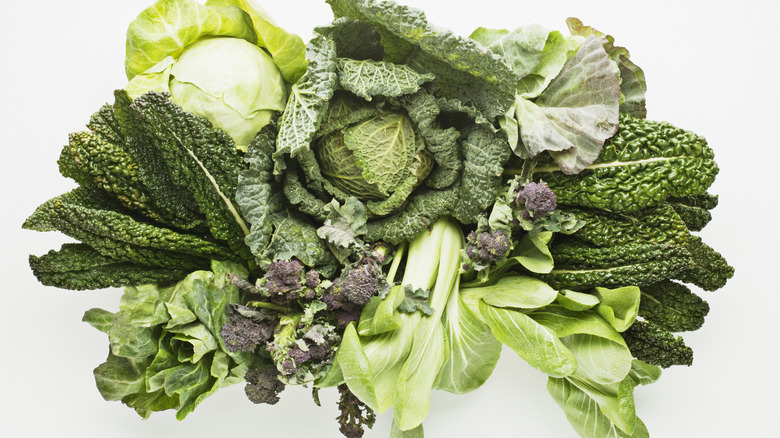What Is Tatsoi And How Do You Cook It?
Tatsoi (Brassica rapa subsp. Narinosa or Brassica rapa var. rosularis) is a leafy green vegetable commonly found in Asian recipes. Tatsoi was first cultivated in China in the 6th century, and was known to be nutritious and thought to have medicinal properties. It soon spread to Korea and made its way to Japan by the 20th century at the latest. In Japan it's known as tasai, while in China it can be called tat choy and jú huā cài, or chrysanthemum vegetable, because it grows into a chrysanthemum shape. The whole plant forms a pretty wreath of tightly-packed dark green leaves and stems.
It's part of the Brassica family, which includes Brussels sprouts, cauliflower, and broccoli. On first appearance, it looks like a flatter, floofier cousin to bok choy, but the leaves are smaller and rounder. It has long been available at markets in China in the winter, but it has started to pop up in North American and European shops. You might see it sold as spinach mustard, spoon mustard, tat soy, tat soi, or rosette bok choy.
If you're curious about this leafy green, you can read on for what it looks like, how to buy it and cook it and if it's good for you (spoiler alert – it's very good for you).
What does tatsoi taste like?
Tatsoi falls into the mustard greens branch of the brassica family. These greens are characterized by their peppery, slightly bitter taste and include kale and collards. While tatsoi is considered a mustard green, the overall flavor profile is milder than that of others in the category. The flavor has been described as sweet with hints of mustardy zing. The leaves are slightly curved or spoon-shaped. The stems are edible and crisp, similar to a tender piece of celery.
Tatsoi can be eaten raw, and the smaller leaves are sweeter and more delicate than the larger leaves. If you happen to have a bunch that has flower buds, those are also edible — they're crunchy and a bit sweet. However, a bolted tatsoi plant means the leaves will taste slightly more bitter. If you can, opt for tatsoi that hasn't bolted yet, as it will be sweeter and more tender. Cooking tatsoi or any winter vegetable tends to mellow the bitterness and cooked tatsoi is similar to spinach both in flavor and texture.
Tatsoi is a surprisingly versatile leafy green
Tatsoi can be steamed, sautéed, or added to soups, and it's an ideal substitute for spinach or bok choy in pretty much anything that calls for them. The younger, smaller leaves are tender and make a good salad base, which is why they are often included in microgreen mixes and bags of salad greens. You can also use tatsoi as a base for an interesting twist on pesto and use it any way you see fit.
If you're looking to use the tatsoi greens in Asian dishes, you can sauté the greens in a wok with some oil, garlic, and perhaps a chili or two as a nice side dish. Tatsoi also makes a great addition to a simple vegetable stir fry; throw it in during the last moments of cooking so the leaves have a chance to wilt, but don't overcook them. You can preserve tatsoi as the Chinese do when they make sour pickled mustard greens. Koreans also use tatsoi in kimchi. The pickled vegetables can be used in soups and stir-fries or eaten on their own.
What to look for when buying tatsoi
Many Asian grocery stores will have tatsoi alongside other leafy greens, most likely in the spring and fall. However, it might still be difficult to find in more conventional places such as your grocery store's produce department. If you do find it, look for leaves that are a deep green. Avoid anything that's bolted, been bruised, or is turning yellow. You can keep the greens wrapped loosely in a damp paper towel in a Tupperware box or plastic bag for five days. Before eating, separate the leaves out and rinse thoroughly. After rinsing in cold water, pat dry. You can leave the tatsoi leaves whole or cut them away from the stems.
If you have the space, tatsoi does really well in a garden; baby leaf tatsoi takes around three weeks while a whole head of tatsoi will take just over a month to mature. If you harvest the plants by cutting just the leaves, they will grow more to replace them. You can reduce food waste by taking just as many outer leaves as you need, and the inner leaves will continue to grow and mature. This tells the plant that it's not time to go to seed yet, so you'll have fresh tatsoi all summer long.
Tatsoi and other leafy greens are excellent for your health
Tatsoi joins its leafy green brethren in the superfood category – it's loaded with healthy nutrients and vitamins and packs a dietary punch. It's high in fiber, low in calories, and all around a great source of various vitamins. It has calcium, which is good for bones and teeth, vitamin C for your immune system, and vitamins A and K, which aid in maintaining healthy skin and blood clotting, respectively. It's also high in folate, a vitamin B that is essential for pregnancy because it helps babies develop a healthy spinal cord.
It might be good for your heart, as studies showed that incorporating more greens into your diet, such as tatsoi, could decrease the risk of heart disease by 16%, while other studies showed a lower risk of stroke and other heart-related problems. It may do all this while potentially preventing diabetes by stabilizing blood sugar. Tatsoi, along with other veggies like broccoli, kale, and cauliflower are good sources of sulforaphane, which studies have shown can prevent certain kinds of cancer.
For its versatility and health benefits, you really can't go wrong with adding tatsoi, or any leafy green, to your regular diet.
